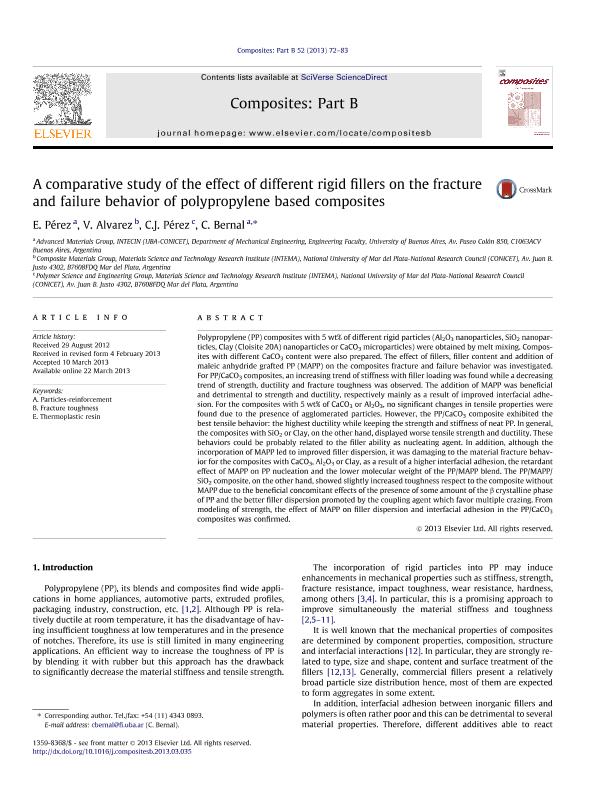Mostrar el registro sencillo del ítem
dc.contributor.author
Perez, Ezequiel Martin

dc.contributor.author
Alvarez, Vera Alejandra

dc.contributor.author
Pérez, Claudio Javier

dc.contributor.author
Bernal, Celina Raquel

dc.date.available
2015-09-25T19:20:26Z
dc.date.issued
2013-03-22
dc.identifier.citation
Perez, Ezequiel Martin; Alvarez, Vera Alejandra; Pérez, Claudio Javier; Bernal, Celina Raquel; A comparative study of the effect of different rigid fillers on the fracture and failure behavior of polypropylene based composites; Elsevier; Composites Part B: Engineering; 52; 22-3-2013; 72-83
dc.identifier.issn
1359-8368
dc.identifier.uri
http://hdl.handle.net/11336/2142
dc.description.abstract
Polypropylene (PP) composites with 5 wt% of different rigid particles (Al2O3 nanoparticles, SiO2 nanoparticles, Clay (Cloisite 20A) nanoparticles or CaCO3 microparticles) were obtained by melt mixing. Composites with different CaCO3 content were also prepared. The effect of fillers, filler content and addition of maleic anhydride grafted PP (MAPP) on the composites fracture and failure behavior was investigated. For PP/CaCO3 composites, an increasing trend of stiffness with filler loading was found while a decreasing trend of strength, ductility and fracture toughness was observed. The addition of MAPP was beneficial and detrimental to strength and ductility, respectively mainly as a result of improved interfacial adhesion. For the composites with 5 wt% of CaCO3 or Al2O3, no significant changes in tensile properties were found due to the presence of agglomerated particles. However, the PP/CaCO3 composite exhibited the best tensile behavior: the highest ductility while keeping the strength and stiffness of neat PP. In general, the composites with SiO2 or Clay, on the other hand, displayed worse tensile strength and ductility. These behaviors could be probably related to the filler ability as nucleating agent. In addition, although the incorporation of MAPP led to improved filler dispersion, it was damaging to the material fracture behavior for the composites with CaCO3, Al2O3 or Clay, as a result of a higher interfacial adhesion, the retardant effect of MAPP on PP nucleation and the lower molecular weight of the PP/MAPP blend. The PP/MAPP/SiO2 composite, on the other hand, showed slightly increased toughness respect to the composite without MAPP due to the beneficial concomitant effects of the presence of some amount of the β crystalline phase of PP and the better filler dispersion promoted by the coupling agent which favor multiple crazing. From modeling of strength, the effect of MAPP on filler dispersion and interfacial adhesion in the PP/CaCO3 composites was confirmed.
dc.format
application/pdf
dc.language.iso
eng
dc.publisher
Elsevier

dc.rights
info:eu-repo/semantics/openAccess
dc.rights.uri
https://creativecommons.org/licenses/by-nc-sa/2.5/ar/
dc.subject
A. PARTICLES-REINFORCEMENT
dc.subject
B. FRACTURE TOUGHNESS
dc.subject
E. THERMOPLASTIC RESIN
dc.subject.classification
Compuestos

dc.subject.classification
Ingeniería de los Materiales

dc.subject.classification
INGENIERÍAS Y TECNOLOGÍAS

dc.subject.classification
Físico-Química, Ciencia de los Polímeros, Electroquímica

dc.subject.classification
Ciencias Químicas

dc.subject.classification
CIENCIAS NATURALES Y EXACTAS

dc.title
A comparative study of the effect of different rigid fillers on the fracture and failure behavior of polypropylene based composites
dc.type
info:eu-repo/semantics/article
dc.type
info:ar-repo/semantics/artículo
dc.type
info:eu-repo/semantics/publishedVersion
dc.date.updated
2016-03-30 10:35:44.97925-03
dc.journal.volume
52
dc.journal.pagination
72-83
dc.journal.pais
Países Bajos

dc.journal.ciudad
Amsterdam
dc.description.fil
Fil: Perez, Ezequiel Martin. Consejo Nacional de Investigaciones Científicas y Técnicas. Oficina de Coordinacion Administrativa Houssay. Instituto de Tecnologías y Ciencias de la Ingeniería "Hilario Fernandez Long"; Argentina
dc.description.fil
Fil: Alvarez, Vera Alejandra. Consejo Nacional de Investigaciones Científicas y Técnicas. Centro Científico Tecnológico Mar del Plata. Instituto de Investigación en Ciencia y Tecnología de Materiales (i); Argentina. Universidad Nacional de Mar del Plata; Argentina
dc.description.fil
Fil: Pérez, Claudio Javier. Consejo Nacional de Investigaciones Científicas y Técnicas. Centro Científico Tecnológico Mar del Plata. Instituto de Investigación en Ciencia y Tecnología de Materiales (i); Argentina. Universidad Nacional de Mar del Plata; Argentina
dc.description.fil
Fil: Bernal, Celina Raquel. Consejo Nacional de Investigaciones Científicas y Técnicas. Oficina de Coordinacion Administrativa Houssay. Instituto de Tecnologías y Ciencias de la Ingeniería "Hilario Fernandez Long"; Argentina
dc.journal.title
Composites Part B: Engineering

dc.relation.alternativeid
info:eu-repo/semantics/altIdentifier/url/http://www.sciencedirect.com/science/article/pii/S1359836813001376
dc.relation.alternativeid
info:eu-repo/semantics/altIdentifier/doi/http://dx.doi.org/10.1016/j.compositesb.2013.03.035
Archivos asociados
